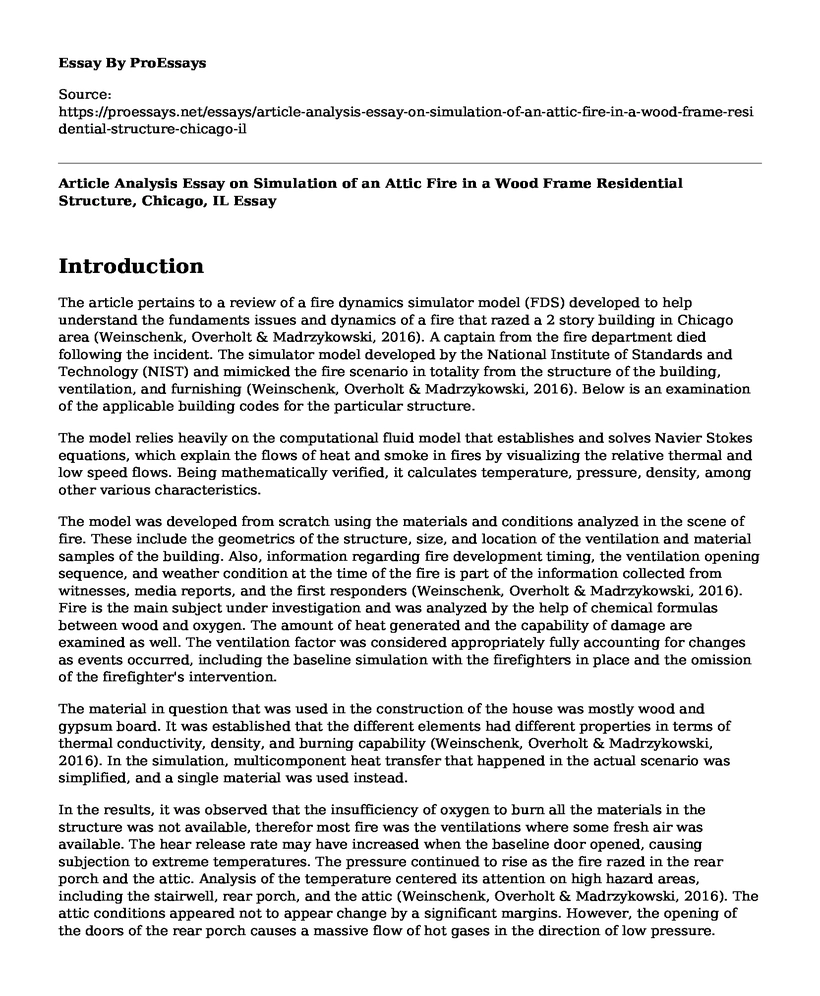Introduction
The article pertains to a review of a fire dynamics simulator model (FDS) developed to help understand the fundaments issues and dynamics of a fire that razed a 2 story building in Chicago area (Weinschenk, Overholt & Madrzykowski, 2016). A captain from the fire department died following the incident. The simulator model developed by the National Institute of Standards and Technology (NIST) and mimicked the fire scenario in totality from the structure of the building, ventilation, and furnishing (Weinschenk, Overholt & Madrzykowski, 2016). Below is an examination of the applicable building codes for the particular structure.
The model relies heavily on the computational fluid model that establishes and solves Navier Stokes equations, which explain the flows of heat and smoke in fires by visualizing the relative thermal and low speed flows. Being mathematically verified, it calculates temperature, pressure, density, among other various characteristics.
The model was developed from scratch using the materials and conditions analyzed in the scene of fire. These include the geometrics of the structure, size, and location of the ventilation and material samples of the building. Also, information regarding fire development timing, the ventilation opening sequence, and weather condition at the time of the fire is part of the information collected from witnesses, media reports, and the first responders (Weinschenk, Overholt & Madrzykowski, 2016). Fire is the main subject under investigation and was analyzed by the help of chemical formulas between wood and oxygen. The amount of heat generated and the capability of damage are examined as well. The ventilation factor was considered appropriately fully accounting for changes as events occurred, including the baseline simulation with the firefighters in place and the omission of the firefighter's intervention.
The material in question that was used in the construction of the house was mostly wood and gypsum board. It was established that the different elements had different properties in terms of thermal conductivity, density, and burning capability (Weinschenk, Overholt & Madrzykowski, 2016). In the simulation, multicomponent heat transfer that happened in the actual scenario was simplified, and a single material was used instead.
In the results, it was observed that the insufficiency of oxygen to burn all the materials in the structure was not available, therefor most fire was the ventilations where some fresh air was available. The hear release rate may have increased when the baseline door opened, causing subjection to extreme temperatures. The pressure continued to rise as the fire razed in the rear porch and the attic. Analysis of the temperature centered its attention on high hazard areas, including the stairwell, rear porch, and the attic (Weinschenk, Overholt & Madrzykowski, 2016). The attic conditions appeared not to appear change by a significant margins. However, the opening of the doors of the rear porch causes a massive flow of hot gases in the direction of low pressure.
Several conclusions can be drawn from the simulation. It is noted that the exposure of the apartment's structure affected the integrity of the structure by weakening it. As such, some doors would not be opened by the firefighters with ease. The opening of the doors resulted in the rapid change of conditions with the high pressure and temperature venting into lower pressure areas (Weinschenk, Overholt & Madrzykowski, 2016). The firefighters are exposed to risk after a prolonged stay in high-temperature areas despite their heavy protective gear which grows softer on continued exposure.
Conclusion
In conclusion, the FDS simulation results indicated that the attic was the most probable place where the fire started before spreading to the rear of the structure where the porch is located. The temperature is too high and under extreme pressures razed the structure without the intervention of external factors. The exact cause of death for the captain is determined s exposure to rapid extreme temperatures resulting in major burns.
Reference
Madrzykowski, D., Overholt, & Weinschenk, C. K. (2016). Simulation of an attic fire in a wood frame residential structure, Chicago, IL. Fire Technology, 52(6), 1629-1658.
Cite this page
Article Analysis Essay on Simulation of an Attic Fire in a Wood Frame Residential Structure, Chicago, IL. (2023, Mar 29). Retrieved from https://proessays.net/essays/article-analysis-essay-on-simulation-of-an-attic-fire-in-a-wood-frame-residential-structure-chicago-il
If you are the original author of this essay and no longer wish to have it published on the ProEssays website, please click below to request its removal:
- Environmental Taxes Essay Example
- Case Study on MHE509 SLP 3
- Essay Sample on Hurricane Rita & Katrina: Two of the Severest Storms to Hit the US Coast
- Essay on Coping with Climate Change and Global Warming
- Essay on China's Paris Pledge: Practically and Ethically Flawed
- Hurricane Katrina and Its Effects Essay
- Paper Sample on Develop Real Estate: Set Goals, Strategies, and Vision







